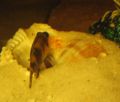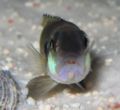Black Occy (Lamprologus speciosus)
From The Aquarium Wiki
Black Occy
Lamprologus speciosus
76 Litres (20 US G.)
4-6 cm (1.6-2.4")
Freshwater
7.4 - 9.0
23 -28 °C (73.4-82.4°F)
7-30 °d
1:1 M:F
3-5 years
Family
Cichlidae
Contents
Additional names
- Black Occy
Additional scientific names
- Lamprologus Ocellatus "Black"
Origin[edit | edit source]
- Endemic to Lake Tanganyika.
Sexing[edit | edit source]
- Very difficult to sex visually. Once the Alpha male has been established, sub dominant males can often act like a female. Mature males are larger than females
- Juveniles : Males grow faster and the lips look bigger and thicker. This can be noticed around 3-3.5cm (1.2-1.4") mark.
- Sub-Adults : Females are much more aggressive. When a shell has been chosen, she would never leave that site while the males will often wonder around the tank.
- Females will also turn half orange/yellow (front half of the body) when fighting amongst females and when they are sexually active.
- Males can do this but rarely. The colouration isn't as intense as the female and would only be for a few seconds.
- Generally an adults will attain the following size.
- Males around 6cm (2.4")
- Females around 4.5cm (1.8")
Tank compatibility[edit | edit source]
- These shelldwelling Cichlids display conspecific aggression which is extremely high amongst females. Contrary to popular belief, they are relatively peaceful towards other tank mates, however they will defend their territories aggressively.
Diet[edit | edit source]
- Not a fussy eater. Live and frozen varieties should form the bulk of the diet, although dried foods are usually accepted.
Feeding regime[edit | edit source]
- Feed once or twice a day.
Environment specifics[edit | edit source]
- Tanganyikan set up is needed with sandy substrate preferred as they will dig. Sharp substrates should be avoided.
Behaviour[edit | edit source]
- Shelldwellers, behaves like similar fish such as Lamprologus ocellatus. These fish can be kept as a pair, or in harem as the alpha male will bond with multiple females.
Identification[edit | edit source]
- See sexing.
Pictures[edit | edit source]
Videos[edit | edit source]
External links[edit | edit source]
- Fishbase (Mirrors:
 )
)







